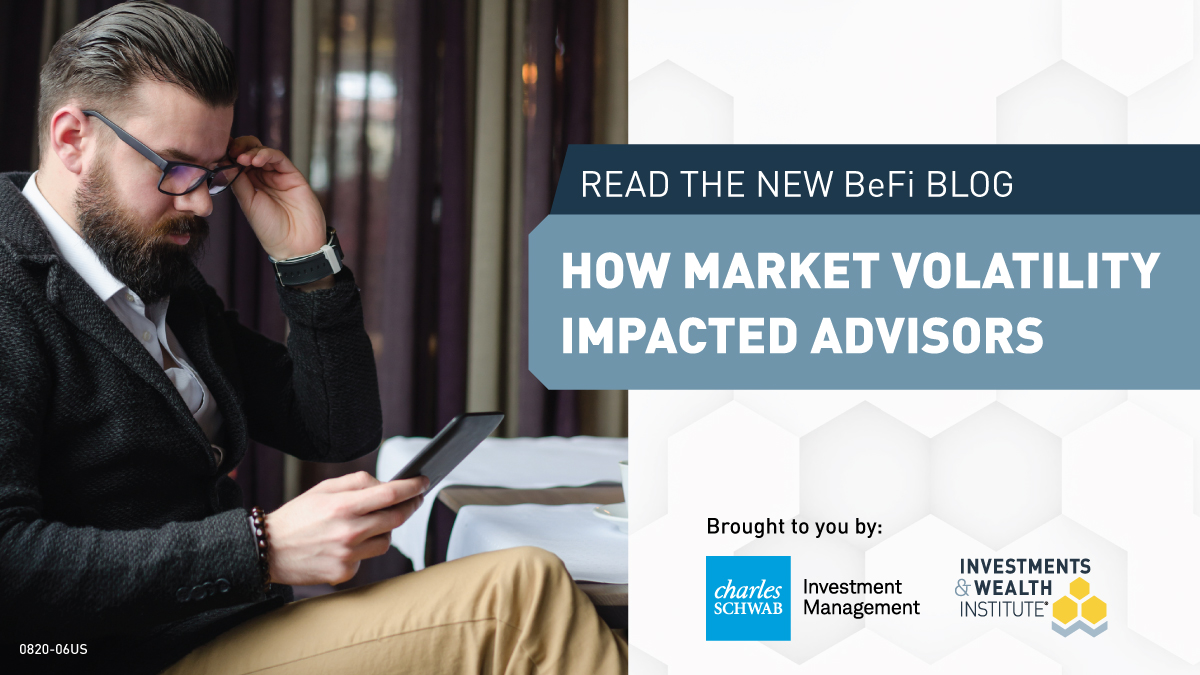Last year, the Investments & Wealth Institute, in collaboration with Charles Schwab Investment Management, Inc. and Cerulli Associates released the BeFi Barometer 2019 which examined the role behavioral finance played in advising clients and how it harnessed better outcomes.

This year, with the current global pandemic and market volatility, the role of applying behavioral finance practices became even more relevant. Our latest research builds upon last year’s research to give advisors a deeper look at how behavioral finance techniques were utilized during the pandemic, when it came to client communication, risk assessment and portfolio construction.
The BeFi Barometer 2020 study found that advisors using behavioral finance gained more clients during Q1. The study also found that those advisors using BeFi techniques are more focused on increasing client communication, enhancing digital capabilities and long-term planning; skills that are beneficial in a good market environment, but particularly critical in an environment of market volatility.
The timing of the study, which surveyed over 300 advisors, was conducted in May and June of 2020, and was particularly fortuitous. Asking advisors about behavioral biases amidst a time of market volatility proved to be incredibly telling.
The study’s findings included:
- More advisors are using behavioral finance compared to 2019, particularly with respect to client communication.
- Advisors saw greater benefit in using behavioral finance to help keep clients invested during market volatility and to develop a better understanding of their clients’ comfort levels related to risk.
- Since Q1, advisors using behavioral finance gained more clients, and increased client communication, to a much larger degree than non-users.
- Loss aversion and overconfidence biases were more pronounced among advisors in 2020 than in 2019, while advisors cited recency bias and loss aversion as the top two client biases.
- Advisors using behavioral finance focused more on proactive investment/portfolio activity since Q1, while non-users were more focused on de-risking client portfolios.
The study also explored the behavioral biases advisors see in their clients and compared those findings from last year.
Similar to 2019, advisors cited recency bias as most common client bias, followed by loss aversion (30% versus 26%) and familiarity bias (27% versus 24%); notable increase in the number of advisors that reported framing bias (26% versus 17%), and mental accounting (26% versus 15%) in 2020.
Advisors are very in-tune to the bias they see in their clients; however, it is important for advisors to understand that they are subject to the same emotional responses as their clients.
Most prevalent advisor biases remained consistent with 2019, although both most prevalent biases, loss aversion and overconfidence, were more pronounced in 2020 than in 2019.
Interestingly, the BeFi Barometer 2020 findings also found that similarly to 2019, the most frequently stated challenge advisors face in using behavioral finance principles in their practices, is the difficulty translating theory into implementation. However, applying BeFi practices create value, so we wanted to share a few easy takeaways to help make your client interactions more meaningful.
Here are 5 key-takeaways that advisors can benefit from:
- Approach clients from an emotional perspective and respond to clients in a more accommodating manner.
- Increase your client communication and use a variety of communication tools with investors. Use a greater combination of 1:1 meetings, texts, emails, and check-ins.
- Review the generational data before making client contact and use those insights to construct a plan of advice and create simple, clinical frameworks. Clients are craving certainty and while you can’t provide that, you can provide a thoughtful, scenario-based analysis.
- Place a greater focus on long-term financial planning and provide more investment and market commentary than you did before, maintaining the strategic asset allocation (re-balancing as needed) and tax-loss harvesting.
- Come to the table with actionable advice around investment and portfolio activity. Keep clients focused on long-term plans but, if changes are required, focus on advising them to make smaller, less permanent changes. For instance, make some changes to their household budgets or for those clients in retirement, suggest that they don’t take an inflation adjustment on distributions for the year, or hold off on re-balancing their portfolio for 12-months. It is important to steer them away from making permanent changes, like selling their home and be willing to make scalable model portfolios and decrease custom portfolios for clients.
By applying the principles outlined in the new BeFi Barometer 2020 report, advisors can mitigate their own biases and increase their awareness around them, especially in this time of great market volatility.
Read the full report: BeFi Barometer 2020
###
Charles Schwab Investment Management: 0820-06Y9

